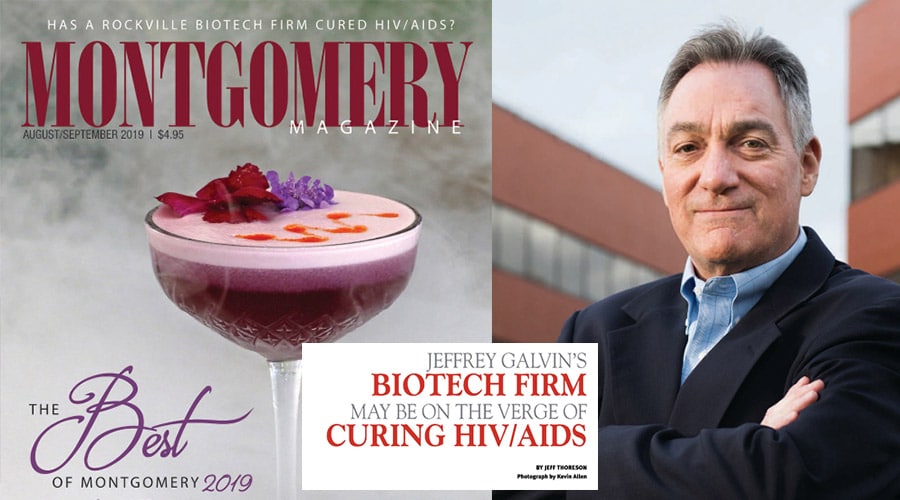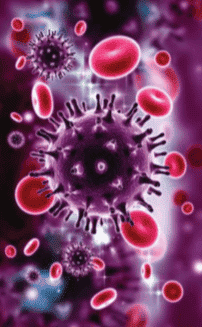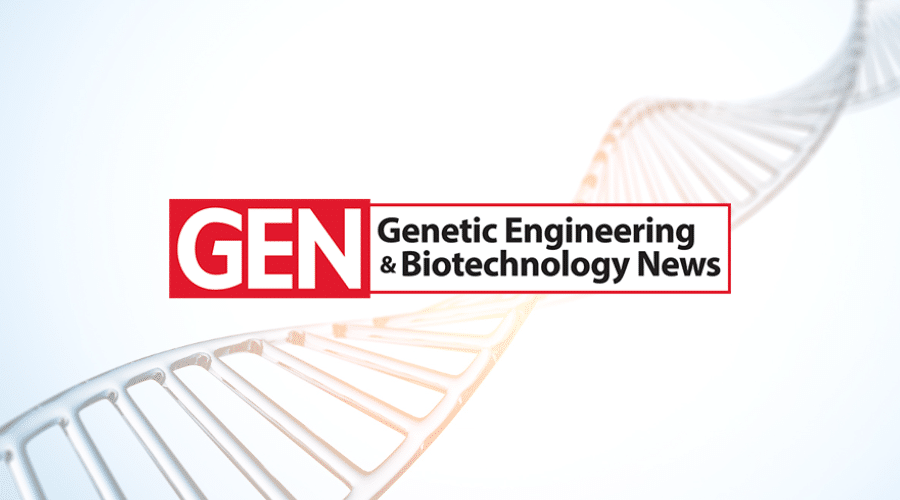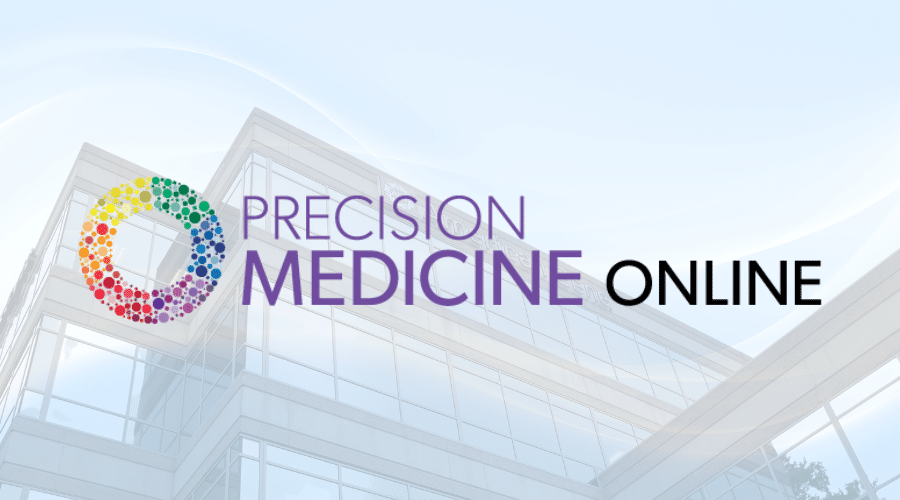Montgomery Magazine: “Jeffrey Galvin’s BioTech Firm May Be on The Verge of Curing HIV/AIDS”

Published by: Montgomery Magazine | Issue: August - September 2019, Page 42
Written by: Jeff Thoreson | Photograph by: Kevin Allen

A 3D RENDERING OF HIV VIRUS IN BLOOD STREAM
Jeffrey Galvin has been a computer nerd since the seventh grade. Way back in the 1970s era of mainframes, he became interested not so much in programming languages or even in circuit boards, but in how the evolving technology would change mankind.
When Galvin was in junior high school, emerging computer scientists saw mainframe, room-size computers as a way to solve mathematical equations and prove theorems. Galvin, on the other hand, started to envision computers as life-changing home appliances.
The story of how this teenage nerd went from dabbling with early computers to being on the verge of curing HIV/AIDS is a tech story that starts in Boston and zig-zags its way through Silicon Valley (naturally) to Hawaii to Medical Center Drive in Rockville where this computer whiz is perhaps on the verge of functionally curing HIV/AIDS.
Galvin’s journey began in Boston where his father was a graduate of MIT, and for young Jeff that meant access to resources at the school. His computer interest ran wild, and he gobbled up so much knowledge that by the time he was 14, he was teaching a programming class at the Massachusetts Institute of Technology (MIT) and, after his acceptance, became the youngest teaching fellow ever at Harvard University.
As a freshman at Harvard, he took all the computer classes he could and naturally aced them all before turning to his major in economics. As a sophomore, he kept his hand in computers by teaching Natural Sciences 110, a computer class for non-computer science students, at times lecturing to as many as 1,200 Harvard undergrads.
As his academic career came to a conclusion, he was recruited by Hewlett Packard and moved to Silicon Valley, where exciting things were beginning to happen with technology. After a few years, he took a job with Apple. He was a rising star in Silicon Valley at tech companies that included Apple and a string of his own successful startups.
As his academic career came to a conclusion, he was recruited by Hewlett Packard and moved to Silicon Valley, where exciting things were beginning to happen with technology. After a few years, he took a job with Apple. He was a rising star in Silicon Valley at tech companies that included Apple and a string of his own successful startups.
“Apple understood what I understood about computers,” Galvin says. “It’s not about computing, it’s bringing the computer into everyone’s life. Apple had a vision for the future of computers, and they understood that power is nothing if it’s not accessible.”
After Apple, he worked on some startup tech businesses. Some hit. Some were sold to public companies. His entrepreneurial life was clicking. And then he had an eureka moment.
“At the age of 41, I looked at my bank account and I realized I didn’t have to work anymore,” he says. “I was really tired because I had been working 16-hour days for like 20 years. You know, the Silicon Valley entrepreneurial schedule.
“So, I thought, OK. That’s it for me. I bought a house in Hawaii and was flying back and forth from Silicon Valley. After about five years, I started feeling bored, so I thought I’d dabble in technology again. Then I met Roscoe Brady.”
By the time Galvin met Dr. Brady, the doctor was in his 70s. He was a highly decorated and commercially successful medical man credited with developing an enzyme replacement technology to extend the life of patients with Gaucher disease, a condition where people can’t metabolize lipids in their organs and the organs swell over time and eventually burst. Brady discovered these patients were missing an enzyme called Glucocerebrosidase, and he figured out a way to produce the enzyme for patients. He out- licensed his biotechnology to Genzyme, which ended up selling $1 billion a year of Brady's treatment.
Over his 50 years as a medical researcher, Brady’s accomplishments can’t be diminished. The National Institute of Neurological Disorders said about Brady: “His work has defined much of what is known about the biochemistry, enzymatic bases, and metabolic defects of these disorders, and he has inspired colleagues throughout the world to define the causes of many other related disorders and to pursue further investigations in this field.”
At the time Galvin met Brady, the doctor was working on advancing gene replacement technology in a laboratory at the National Institutes of Health (NIH), but he was getting ready to retire. Brady’s explanation of his research registered with Galvin, even though he had no medical training.
“Roscoe didn’t know me from Adam, and I walked into his office and he treated me as some sort of peer. He was going to explain to me what he knew. He explained it so well it was easy for me to understand it right away, and I just said to him, ‘You know, somebody’s going to have to be the Microsoft of this industry and it might as well be us.’”
But Brady was retiring, and NIH was shutting down his lab. The Bethesda facility offered the intellectual property to Galvin.
"I got the most advanced lentiviral vector system on the planet, for free. I hired some post-docs from his lab because I saw a future in this. I thought NIH was about to throw away the most valuable thing I’d ever seen." What Galvin recognized was that Brady’s work was similar to his field of expertise. Essentially, biotechnology researchers like Brady were working on reprogramming human genes, removing the inadequate functions of genes and replacing them with functioning abilities. Galvin related that to computer programming. He saw gene replacement technology as the human body’s programmable hardware and became excited about coming out of retirement himself and diving into the biotech field.
"I got the most advanced lentiviral vector system on the planet, for free. I hired some post-docs from his lab because I saw a future in this. I thought NIH was about to throw away the most valuable thing I’d ever seen." What Galvin recognized was that Brady’s work was similar to his field of expertise. Essentially, biotechnology researchers like Brady were working on reprogramming human genes, removing the inadequate functions of genes and replacing them with functioning abilities. Galvin related that to computer programming. He saw gene replacement technology as the human body’s programmable hardware and became excited about coming out of retirement himself and diving into the biotech field.
Galvin recognized that a hugely successful, retiring research scientist like Brady wasn’t going to go back to work for a startup. But Brady’s friendship and encouragement led Galvin to create American Gene Technologies (AGT).
"He wasn’t going to go back to the bench, back to work and be that kind of founder, but he was a cheerleader. He was our inspiration. He was someone who gave me great confidence during those early years, and he supported my vision for what this could become as well as lending a guiding hand whenever he could."
Brady died in 2016 at the age of 93, but the suite of offices and labs of AGT on Medical Center Drive in Rockville continues to advance gene replacement technology with Brady’s memory ever present.
It is sad that Brady couldn’t have lived to see where Galvin is now. Using the research done by Brady and other gene therapists since the 1970s and his own sense of computer programming, Galvin envisioned a process whereby a new recipe could overwrite a person’s defective genetics, essentially installing a new DNA system. Even in 2008 when he founded AGT, it was cutting-edge thinking.
It is sad that Brady couldn’t have lived to see where Galvin is now. Using the research done by Brady and other gene therapists since the 1970s and his own sense of computer programming, Galvin envisioned a process whereby a new recipe could overwrite a person’s defective genetics, essentially installing a new DNA system. Even in 2008 when he founded AGT, it was cutting-edge thinking.
In a little more than a decade, that research has evolved into the company quite possibly being on the verge of curing the HIV/AIDS virus.
But science has stepped on this threshold in the past. Shortly after the AIDS virus was identified, the medical community said there would be an immunization for it within a couple of years. That was three decades ago.
In 2009, two patients in Boston were free of the virus for several months following bone marrow transplants and thought to be cured, but the virus rebounded in both men.
What makes HIV so insidious is that it takes infected genes and bolts them onto a person’s DNA as permanent changes. The cells don’t look any different to a patient’s immune system so HIV can be in your body for years without detection, slowly taking over the immune system.
This is what happens to an HIV- infected patient. It’s what happened to Timothy Ray Brown, now infamously known as “the Berlin Patient.” Brown, born in Seattle, was diagnosed with the disease in 1995 and used antiretroviral drugs to stave off HIV for more than a decade. Then he was diagnosed with deadly acute myeloid leukemia. Doctors essentially destroyed his immune system and rebuilt it with donated stem cells – but not just any stem cells. They curated the cells from a person immune to HIV.
Decades of HIV research found that between 0.3 percent and 0.7 percent of the northern European population is naturally immune to HIV because they are born with a defect in their genes. Their cells don’t have what is known as C-C chemokine receptor type 5 (CCR5), a protein that opens the door for HIV to enter blood cells.
For Brown, it meant a new chance at life. He received two stem cell transplants that knocked out his cancer and transferred the genetic variation to his immune system.
Building on this and on Brady’s research of getting a missing gene into a cell, AGT started working toward reprogramming cells with viral vectors, which can deliver genetic material into broken cells in the body as if they were rewriting a faulty computer program.
The most intuitive use of these viral vectors is to install a missing or broken gene into a patient’s system. Galvin recognized that as the ability to install new software in a patient’s operating system, his DNA.
“We could essentially put in genes that would make you healthier,” he says.
What Brady saw, and which AGT is leveraging in its research, is the ability to take out the disease genes of a virus that would normally infect a cell.
The viral vector used in AGT’s HIV program is actually a derivative of the HIV virus. This derivative is called a lentivirus, for the general class of slow-moving viruses of which HIV is a member. Scientists have developed reliable methods for “cracking open” viruses – even the most frightening and deadly viruses such as HIV – and “scooping out” the genetic constructs that make up the actual payload of the virus and cause disease.
Once emptied of their original “viral cargo,” the remainder of the virus (essentially the “shell” or “envelope”) can be used to deliver a variety of genetic payloads that actually improve the operation of cells that they infect. This use of the delivery capabilities of modified viruses is called viral vectors.
Viral vectors can deliver new genes to replace or enhance functions that are missing or broken in the DNA of the cell, or to create interrupting RNAs that can effectively “turn off” genes that may be creating negative effects in the cell. The ability of viral vectors to “upregulate” or “downregulate” human genes in the DNA of human cells is a rudimentary way to “reprogram” their operating “software.”
When scientists change the DNA of a cell, it affects the operation of the cell at the deepest levels. This technique has enormous power and, properly used, can enhance the operation of cells and create highly effective, targeted drugs for a wide variety of human diseases. Today, there are already a few FDA-approved cancer therapies which use lentivirus to deliver a genetic package.
“Replacing broken or defective genes in inherited diseases is the most obvious use for viral vectors. Now we have an empty stealth bomber that can install any gene,” Galvin says. “We can install new software in your operating system, your DNA. We could essentially put in genes that would make you healthier. If you had a broken gene and were missing an enzyme, we could install a gene that creates that enzyme and is permanent. Now you’re the medicine. Your body makes the thing that you were missing.”
Similar research recently cured Leber’s congenital amaurosis, a rare inherited eye disease that appears at birth or in the first few months of life. The result is that children who faced blindness are now regaining their sight.
“This is what excited me when I met Roscoe Brady back in 2007. I said, ‘Wow, we would turn viruses into updates.’ My understanding of biology was that DNA was your operating system. These viral vectors would allow us to go in and manipulate it for better health. So, viruses that would make you sicker could be hijacked into bringing in genes that could make you healthier. I saw this as the future of medicine.”
Now, more than a decade later, AGT has put all of this research and theoretical work together, and sometime in the third quarter of this year will submit to the FDA the final analysis of its Investigational New Drug (IND) findings for the patented gene therapy that Galvin and AGT scientists believe will cure HIV/AIDS.
The IND is the last document that goes to the FDA in a very long negotiation of what safety data you need to show them before being allowed either to infuse or insert something in a human body. If the FDA finds no flaws, it will clear the legal path for the biotechnological cure for HIV/AIDS to be tested in HIV-positive human volunteers.
AGT researchers have treated the blood from nine HIV-positive individuals with its gene replacement technology and Galvin says it works in the lab.
“We can’t re-infuse the blood yet, but we have the blood product in our lab that we can test. We can see that when you throw as much HIV into that blood as you want, it clears itself,” he says. “If we put this blood product back into the patient, it is likely to clear the whole body and work just like the Berlin Patient.”
While the bone marrow transplant worked once in Berlin decades ago, and once again recently in a patient in London, it is unrealistic for that to be a logistical or economical way to cure HIV/AIDS.
So, AGT developed autologous cell therapy where 400 milliliters of blood from a patient is used to isolate the HIV specific T cells (the cells that play a central role in the body’s immune response system) and then modify them so they don’t have CCR5. That means the first T cells that rush to the HIV virus when they enter the body can’t be hijacked by the virus and rendered useless so the disease can spread.
“Then we culture them up to sufficient levels to cure HIV and put them back into your body,” Galvin says. “Theoretically, it should work just like the Berlin Patient while not requiring the expense or trauma of a bone marrow transplant.”
AGT developed the cell protocol on a table-top unit that can go anywhere in the world. It costs approximately $200,000, and with it, any hospital that can conduct leukapheresis (a procedure in which white blood cells are separated from a sample of blood) and an infusion could be curing HIV.
“So, this is really commercial-izable,” Galvin says.
A patient would go to the hospital and be hooked up to a machine that filters blood, almost like dialysis but not quite as serious. The filtering pulls out white blood cells collecting a sample that is enriched for T cells. The filtered blood is put into this tabletop unit and spends 11 days undergoing the processes to make them into “super” cells that are un-depletable and uninfectable by HIV.
During that process the T cells are modified so they don’t have CCR5 and HIV virions can’t get ahold of them. The AGT process also puts in what are known as short interrupting RNA (a polymeric molecule essential in various biological roles in coding, decoding, regulation and expression of genes) that shut down any strain of HIV.
“Then we have these super cells that we culture up to the number that we need,” says Galvin. “At the end of this 11-day process, we have the blood product that’s ready for reinfusion.”
The patient comes in again, receives a dose of a mild cytotoxic drug that clears out some space to infuse the improved T cells. This is necessary because the body’s T cell population has recovered and is full again, so the patient may reject additional T cells due to crowding if the T cell population in the circulatory system is not reduced before an infusion of new T cells. Once the patient’s circulating T cells are reduced, the processed blood is reinfused. In a few weeks, the patient recovers from the infusion, the infused T cells become fully active again, and the patient can theoretically go off the meds and be immune for life, like Timothy Ray Brown.
“Theoretically, we can get you to that state and you would never have to take antiretroviral therapy again. You can’t ever progress to AIDS. You could never give the virus to anyone else and you can never re-contract any version of HIV,” Galvin says.
Of all the great biotechnological research going on in Montgomery County, this may be the most exciting. And like all of that research, this is just the beginning.
“This is a very exciting thing that we’re right on the eve of,” says Galvin. “This is another miracle-type therapy of the basic gene/cell category.”
View The Original Article
This page is a replication of the original content. To respect the original publisher, this page is not indexed by search engines. The original article can be viewed by clicking the button below.





